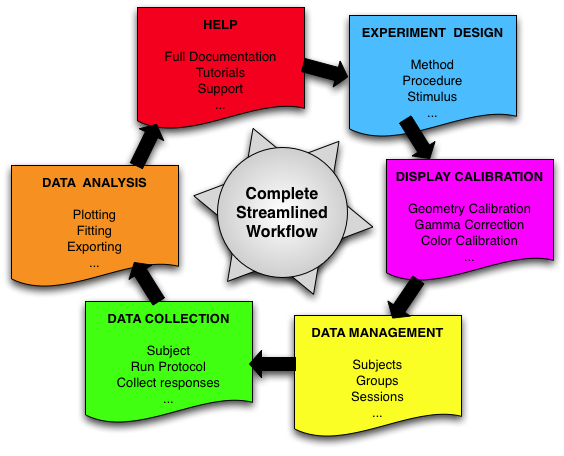
 |
Introduction |
Psykinematix is an OpenGL-based software package dedicated to visual psychophysics running on macOS computers (from Mac OS X 10.4 "Snow Leopard" to macOS 10.14 "Mojave"), and which takes advantage of numerous advanced technologies available on the Macintosh platform like OpenGL, Quicktime, Accelerate Framework, etc. Psykinematix was developed with the goal of simplifying the creation of complex experimental paradigms in the context of psychophysical and electrophysiological studies of spatial, temporal and color aspects of human vision. Psykinematix eases the elaboration of standard protocols, by providing a simple experimental paradigm (Method/Procedure/Stimulus) and an intuitive graphic user interface (GUI) that abstracts most of the psychophysical concepts.
Psykinematix features a unique stand-alone application that does not require the user possess any programming skills in order to create and run complex psychophysical experiments. Its aim is to provide an easy-to-use and subject-friendly environment that allows you to calibrate your experimental setup, run standard psychophysical protocols, present complex stimuli, collect subjects' responses, and analyze session results on the fly, all in one integrated software package providing a complete streamlined workflow.

While Psykinematix does not require you be proficient in visual psychophysics, it does assume, however, you have some basic knowledge in this field. If you teach experimental psychology, you can also use Psykinematix as a learning tool to introduce visual perception and illustrate psychophysical concepts to your students in the classroom.
Psykinematix features:
We hope you will become more productive with Psykinematix, and have fun with it!
To learn more about Psykinematix, you may start browsing the built-in documentation included in the following sections or fast-track with the tutorials:
Getting Started
Panel Tools
Building Experiments
Stimuli Creation
Running a Session
Support
Miscellaneous
© 2006-2024 KyberVision Japan LLC. All rights reserved.
Mac, Macintosh, Mac OS, QuickTime and the names of Apple products referenced herein are trademarks of Apple Inc., registered in the U.S. and other countries. OpenGL is a registered trademark of Silicon Graphics, Inc.